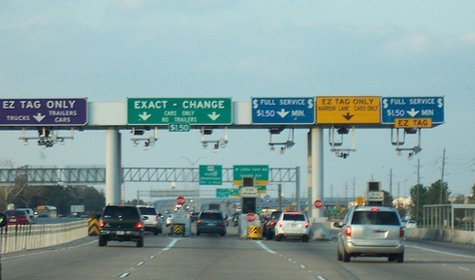It was so predictable. The people of Texas revolted against former Governor Rick Perry’s grand network of toll roads, once dubbed the Trans Texas Corridor, and many grassroots groups that sprung up to oppose it predicted its eventual demise. The press, always eager to jump on the ribbon cuttings, seldom show you the angling inside bankruptcy court, yet that’s where State Highway 130 Concession Company ended up. As part of its Chapter 11 bankruptcy, Spain-based Cintra and San Antonio-based Zachry ceded the delinquent toll project to its creditors Friday.
The southern 41-mile stretch of SH 130, a bypass designed to avoid Austin traffic from Mustang Ridge to Seguin, opened with much fanfare in November of 2012, including an appearance by Perry who hailed this first public private partnership (or P3) as highway nirvana and ‘visionary.’ But crony capitalism is as old as dirt and taxpayers didn’t see it as anything other than graft.
Dan Shelley, a consultant for Cintra, got hired as Perry’s legislative liaison in 2004 where he secured Cintra the exclusive right to develop the Trans Texas Corridor. Then Shelley promptly went back to work for Cintra once the session ended, this time adding his daughter, Jennifer Shelley-Rodriguez, to Cintra’s payroll. Cintra received two more P3 contracts, one in Dallas for I-635 and another in Ft. Worth for I-820 that, all told, gave the company the right of first refusal on 4 separate projects there. Just those three deals add up to over $5 billion in state contracts handed to a single company with direct ties to Perry’s office.
So it shouldn’t surprise anyone that taxpayers will be left holding the bag on SH 130. While the Texas Department of Transportation (TxDOT) and its buddy, Cintra, are quick to point out no state money went into the SH 130 contract, plenty of federal money did. A $430 million dollar federal TIFIA loan to be exact. Cintra-Zachry only put $210 million into the $1.3 billion project, less skin in the game than the public.
With taxpayers as a chief creditor, why is it that Texans do not get this road back in the public’s hands now that it’s gone bankrupt? Well, that’s because TxDOT, who signed the contract under the direction of Perry, didn’t ensure taxpayers would get it back if the private operators went bankrupt. The senior bank loan lenders get it. The way TIFIA loans are structured, the taxpayers get repaid last, and usually for pennies on the dollar if it’s anything like the South Bay Expressway in San Diego.
That P3 tollway was the first to receive a TIFIA loan and it went bankrupt in less than three years, similar to SH 130. Federal taxpayers had to take a nearly $80 million hit for losses on that loan. It, too, was taken over by its lenders and then resold to San Diego’s council of governments for almost half the original cost, using yet another TIFIA loan to pay-off part of the first one. While that may sound like the taxpayers still got a good deal by purchasing the road for far less than the original price tag, buyer beware.
According to a report by the Congressional Budget Office [PDF], the taxpayers are worse off than before, “The new financing and ownership structure required by the bankruptcy court imposed a loss of 42 percent on federal taxpayers, replacing the original TIFIA investment with a package of debt and equity worth only 58 percent of the original investment.”
So there’s very little to celebrate now that Cintra has let go of SH 130. This cycle of selling it off to the next sucker until that deal goes south could go on for the life of the original contract — up to 52 years. All the while, taxpayers are being positioned to take multiple blows at the behest of global corporations teaming-up with politicians and, by extension, the un-elected bureaucrats in Austin and Washington who are bent on sticking it to the public. Taxpayers foot part of the bill for the project then get forced to repay it with interest over and over again, while still paying tolls to use it.
It’s nice work if you can get it when you’re the insider, but P3s symbolize why angry voters are flocking to Donald Trump — to get a better deal for taxpayers. The best solution moving forward is to build freeways not tollways and to ensure that taxpayers get these bankrupt projects back in the hands of the public.
Terri Hall is a citizen activist who founded the statewide group Texas TURF (Texans Uniting for Reform and Freedom) when she learned that TxDOT was to convert her only access to San Antonio, Hwy 281, into a tollway (which is a double tax to charge taxpayers again for what they’ve already built and paid for) and when she saw a major shift in Texas transportation to tolling our existing freeways. She has worked in two sessions of the Texas Legislature, spoken before 12,000 people at a rally in Washington D.C., organized marches on Austin, spoken at national conferences, appeared on both the Lou Dobbs Show, CNN’s American Morning, and Fox News nationally, and done local radio & TV interviews all over Texas. She also writes for the Express-News and Houston Examiner and has had many columns published by news outlets nationwide. This article appeared at: http://www.texasturf.org/2012-06-01-03-09-30/latest-news/public-private-partnerships/2163-cintra-hands-sh-130-to-its-creditors



:quality(75)/https://static.texastribune.org/media/files/fd00248f901ee5091236eb0fa0473743/DPS%20Texas%20Capitol%20MG%20TT%2010.jpg?resize=440,264)
:quality(75)/https://static.texastribune.org/media/files/474ce36c7dc42f4b4356ffa483e275a9/SpaceX%20Brownsville%20MGO%20TT%2005.jpg?resize=440,264)
:quality(75)/https://static.texastribune.org/media/files/3dd0fae2a594c7ae8cf4695805d8ebaa/Biden%20Levee%20Construction%20EG%20TT%2016?resize=440,264)
